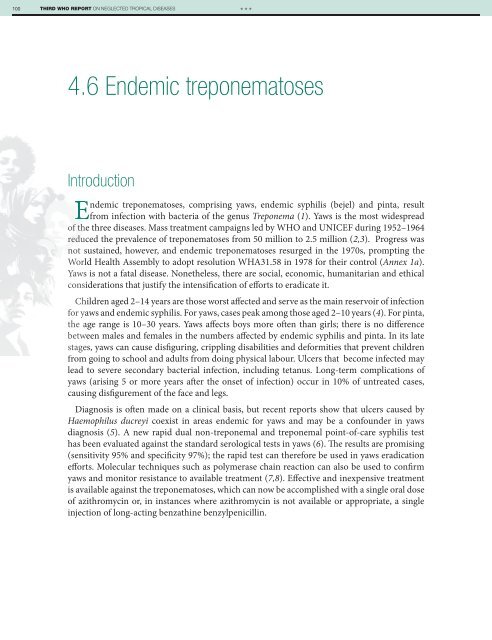1A9bnbK
1A9bnbK
1A9bnbK
Create successful ePaper yourself
Turn your PDF publications into a flip-book with our unique Google optimized e-Paper software.
100 THIRD WHO REPORT ON NEGLECTED TROPICAL DISEASES<br />
***<br />
4.6 Endemic treponematoses<br />
Introduction<br />
Endemic treponematoses, comprising yaws, endemic syphilis (bejel) and pinta, result<br />
from infection with bacteria of the genus Treponema (1). Yaws is the most widespread<br />
of the three diseases. Mass treatment campaigns led by WHO and UNICEF during 1952–1964<br />
reduced the prevalence of treponematoses from 50 million to 2.5 million (2,3). Progress was<br />
not sustained, however, and endemic treponematoses resurged in the 1970s, prompting the<br />
World Health Assembly to adopt resolution WHA31.58 in 1978 for their control (Annex 1a).<br />
Yaws is not a fatal disease. Nonetheless, there are social, economic, humanitarian and ethical<br />
considerations that justify the intensification of efforts to eradicate it.<br />
Children aged 2–14 years are those worst affected and serve as the main reservoir of infection<br />
for yaws and endemic syphilis. For yaws, cases peak among those aged 2–10 years (4). For pinta,<br />
the age range is 10–30 years. Yaws affects boys more often than girls; there is no difference<br />
between males and females in the numbers affected by endemic syphilis and pinta. In its late<br />
stages, yaws can cause disfiguring, crippling disabilities and deformities that prevent children<br />
from going to school and adults from doing physical labour. Ulcers that become infected may<br />
lead to severe secondary bacterial infection, including tetanus. Long-term complications of<br />
yaws (arising 5 or more years after the onset of infection) occur in 10% of untreated cases,<br />
causing disfigurement of the face and legs.<br />
Diagnosis is often made on a clinical basis, but recent reports show that ulcers caused by<br />
Haemophilus ducreyi coexist in areas endemic for yaws and may be a confounder in yaws<br />
diagnosis (5). A new rapid dual non-treponemal and treponemal point-of-care syphilis test<br />
has been evaluated against the standard serological tests in yaws (6). The results are promising<br />
(sensitivity 95% and specificity 97%); the rapid test can therefore be used in yaws eradication<br />
efforts. Molecular techniques such as polymerase chain reaction can also be used to confirm<br />
yaws and monitor resistance to available treatment (7,8). Effective and inexpensive treatment<br />
is available against the treponematoses, which can now be accomplished with a single oral dose<br />
of azithromycin or, in instances where azithromycin is not available or appropriate, a single<br />
injection of long-acting benzathine benzylpenicillin.


